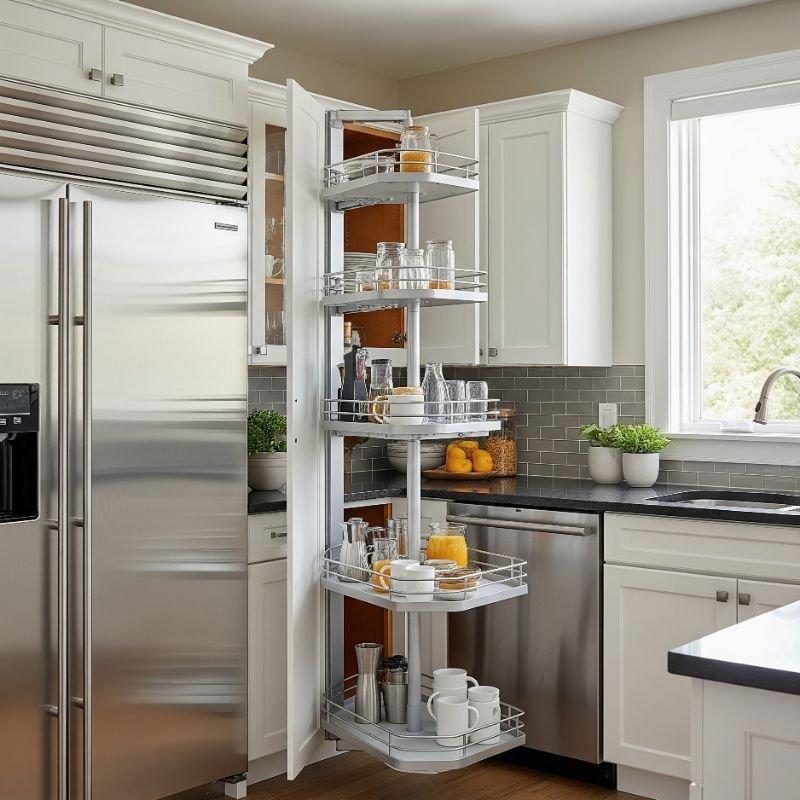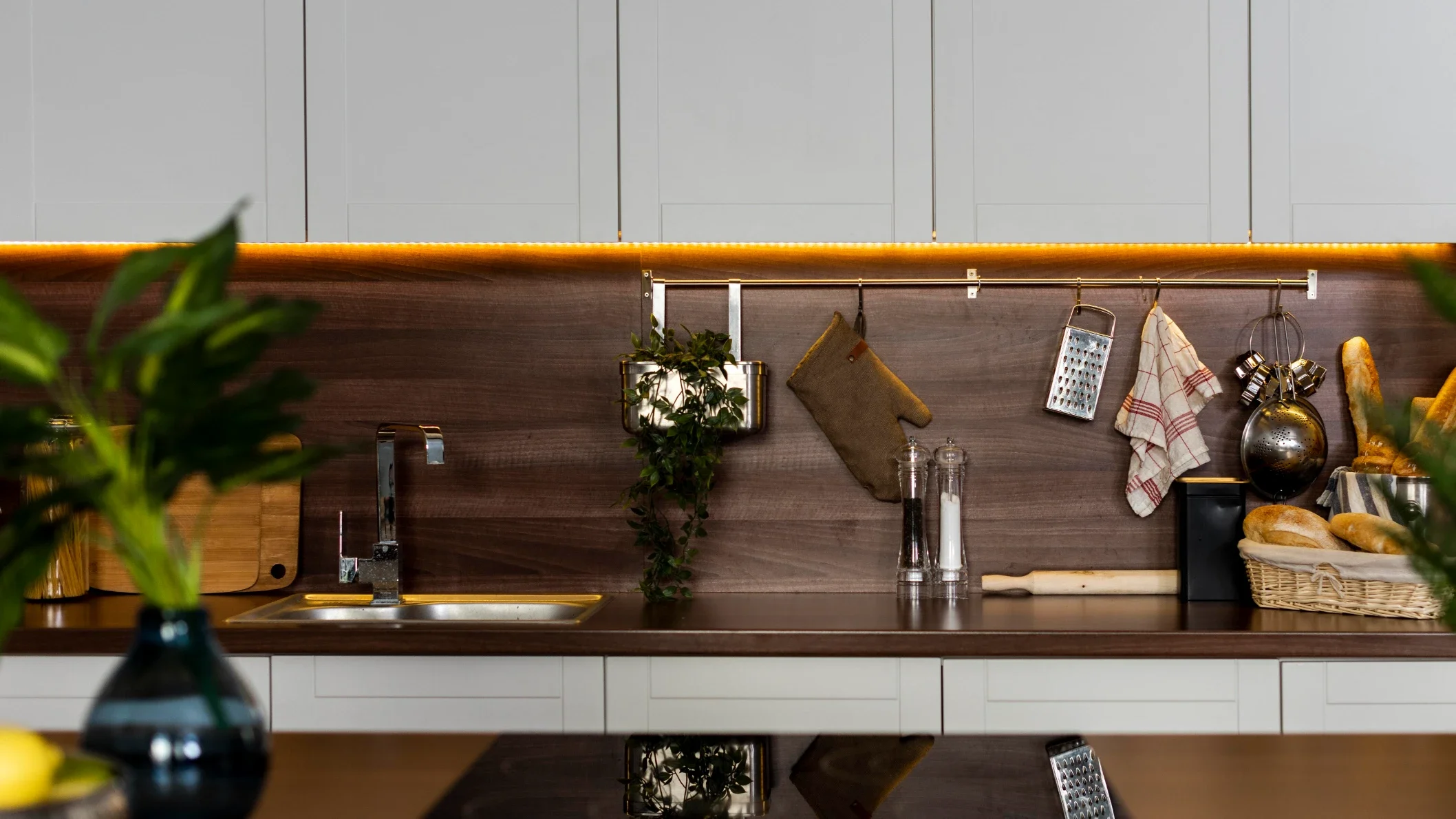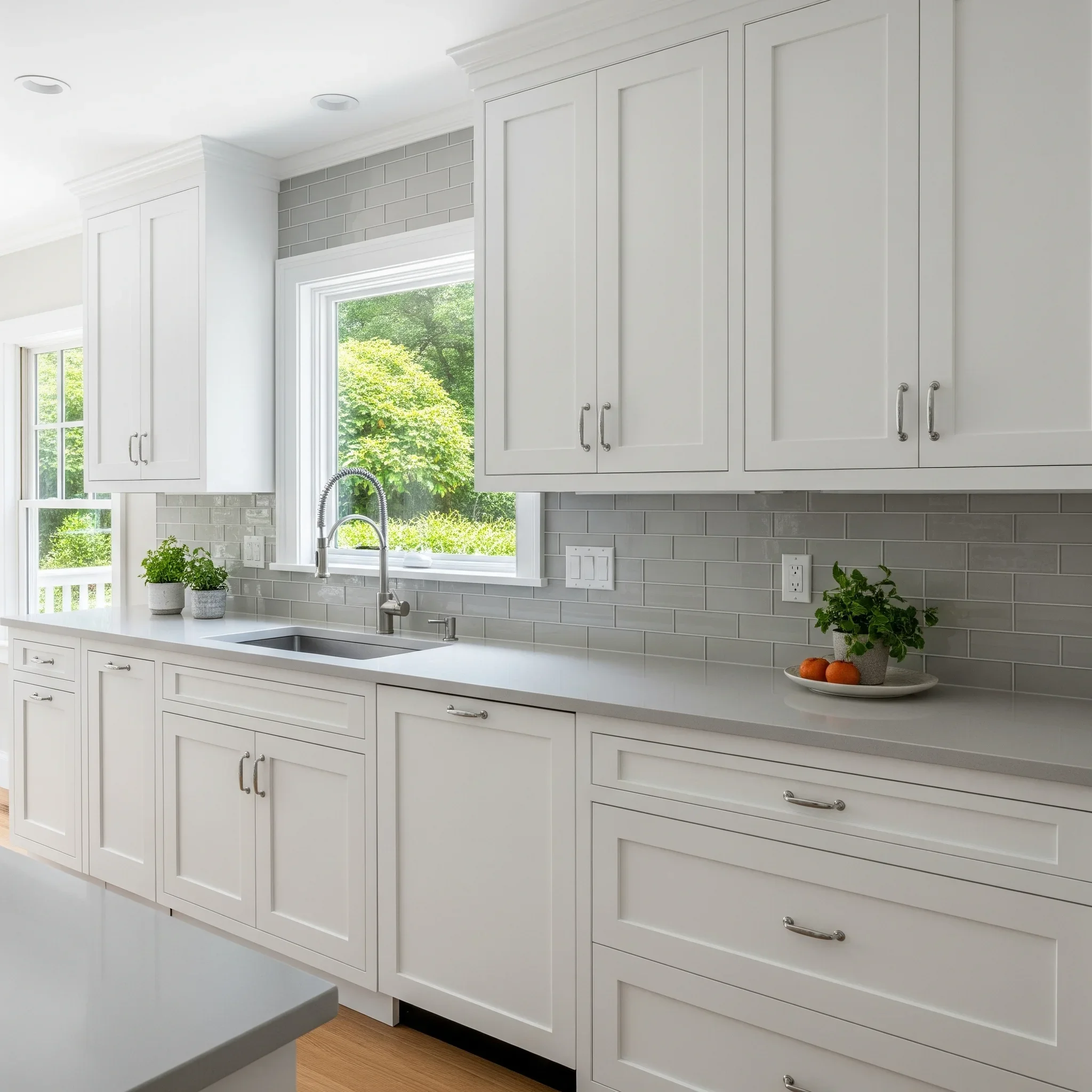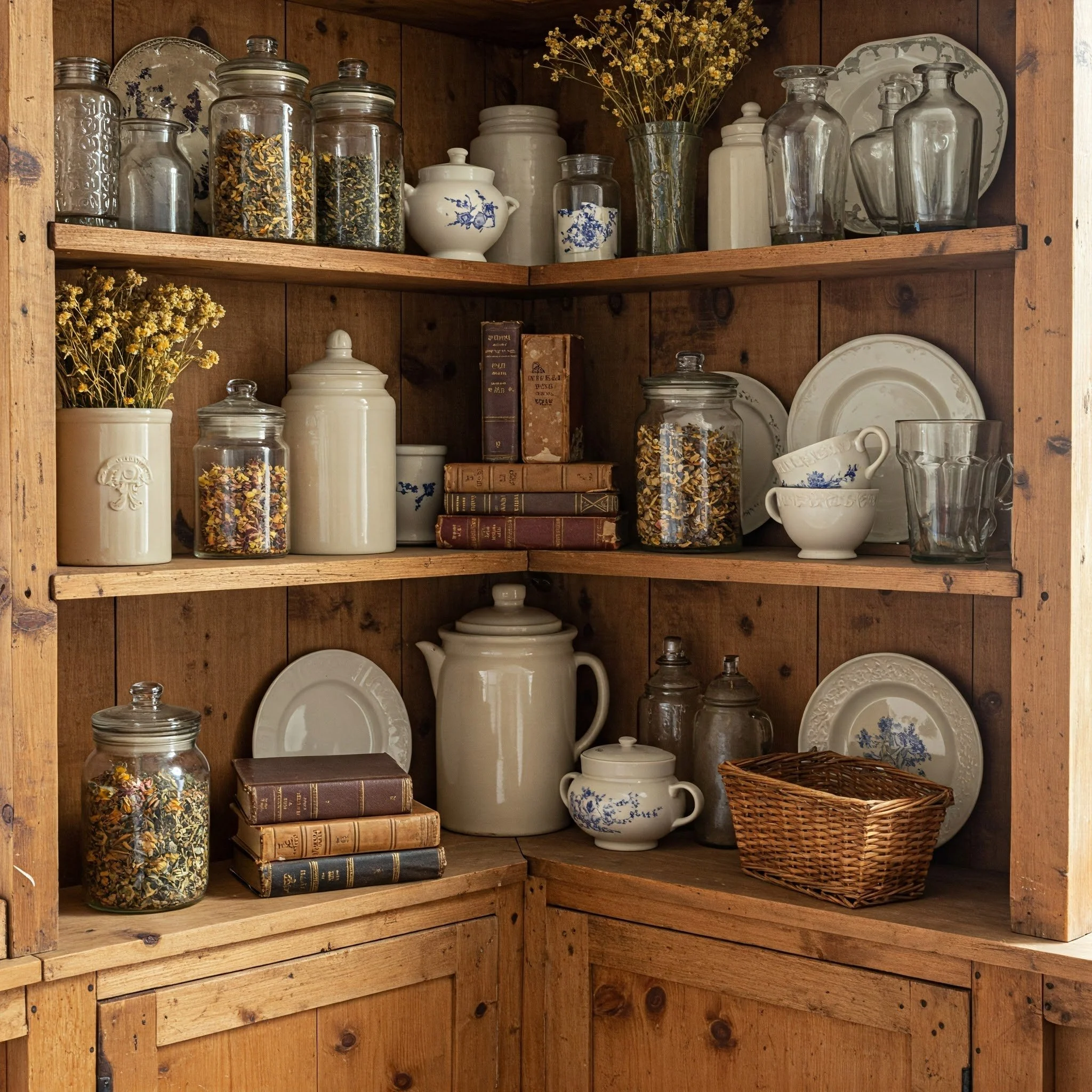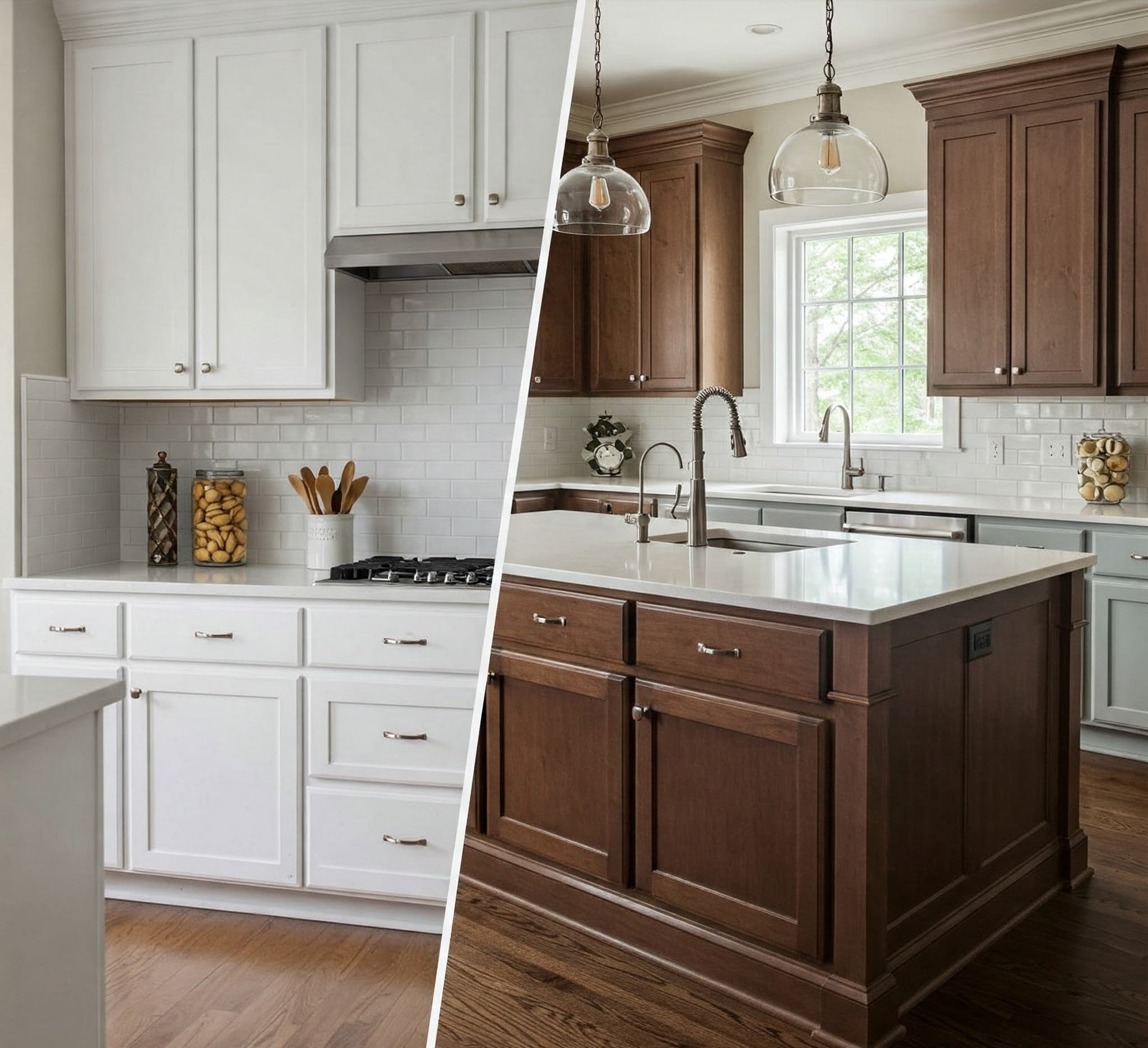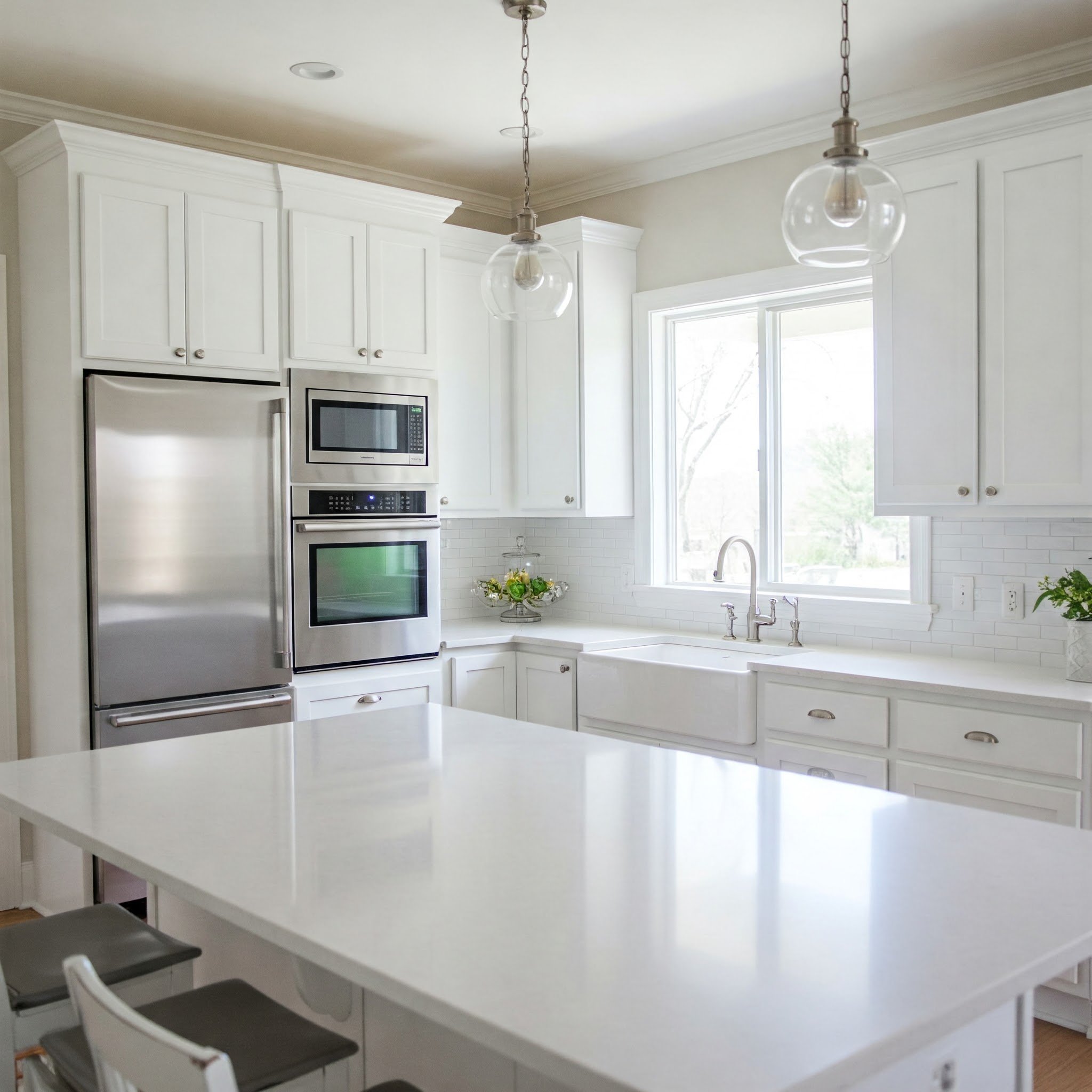15 Blind Corner Kitchen Cabinet Ideas That Maximize Space
Discover 15 clever blind corner cabinet solutions that transform wasted kitchen space into functional storage areas you'll actually use every day.
Have you ever found yourself contorted into an uncomfortable yoga pose, arm stretched to its absolute limit, fingers desperately trying to reach that one pot that's somehow migrated to the darkest recesses of your corner cabinet? You're not alone in this kitchen struggle. The infamous blind corner cabinet—that awkward L-shaped void where two perpendicular cabinets meet—has long been the Bermuda Triangle of kitchen storage, where good intentions and seldom-used appliances disappear, never to be seen again until you move. These problematic corners exist in almost every kitchen, consuming valuable square footage while providing frustratingly inaccessible storage that typically ends up wasted. But what if I told you that this challenging space could become one of your kitchen's most functional and efficient storage areas? With thoughtful planning and innovative hardware solutions, you can transform these awkward corners from organizational nightmares into storage dreams. Whether you're planning a complete kitchen renovation or simply looking to upgrade your existing cabinetry with retrofit solutions, these 15 blind corner cabinet ideas will help you reclaim every precious inch of your kitchen's forgotten territory, bringing light to the darkness and order to the chaos.
1. Pull-Out Corner Drawers: Diagonal Access Solutions
Imagine transforming that awkward corner void into a series of drawers that glide toward you at a diagonal angle, bringing every stored item into full view. Pull-out corner drawers operate on specialized hardware that allows the entire drawer unit to move outward and to the side, following the natural L-shape of your corner space. Unlike traditional drawers that move in a single direction, these ingenious solutions travel along two axes, making use of the entire corner depth without requiring you to reach into darkness. I particularly love how these units typically offer multiple drawers of varying heights, allowing you to organize items by category and size—shallow drawers for utensils and gadgets, deeper ones for pots and appliances. The full-extension slides ensure you can access the entire drawer contents, while soft-close mechanisms prevent slamming. It's like having a secret storage compartment that elegantly solves the corner conundrum without wasting a single inch.
2. Magic Corner Systems with Independent Swing-Out Shelves
The aptly named "Magic Corner" truly lives up to its moniker, performing a mechanical sleight of hand that transforms inaccessible space into easily reached storage. This system consists of two sets of shelving units: the front set attached to the cabinet door, and the rear set connected via an ingenious sliding mechanism. When you pull the door open, the front shelves move forward and to the side, simultaneously drawing the rear shelves from the cabinet's dark recesses into the light. The beauty of this system lies in its independent operation—each shelf moves individually, providing complete access to stored items without requiring you to move other contents first. Think of it as a mechanical dance partner that gracefully leads hidden items out where you can reach them with ease. The weight-bearing capacity impresses too, with quality systems supporting up to 20 pounds per shelf. For homes where storage space comes at a premium, the Magic Corner reclaims previously surrendered territory with mechanical elegance.
3. Lemans Corner Units: The Sweeping Shelf Revolution
Named after the famous French racetrack for their distinctive sweeping motion, LeMans units have revolutionized corner cabinet accessibility with their elegant solution to a clunky problem. These systems feature kidney-shaped shelves that pivot completely out of the cabinet on a sophisticated track system, bringing the entire contents into full view and reach. Unlike lazy Susans that still leave portions of their contents partially obscured, LeMans shelves sweep every item entirely outside the cabinet confines. The fluid motion resembles a graceful dancer extending their arm in a sweeping arc—beautiful in both form and function. Each shelf operates independently, allowing access to specific contents without disturbing other items. The slightly raised shelf edges prevent items from sliding off during their journey, while the non-slip surface coating provides additional security for your kitchen equipment. I've found these units particularly effective for storing heavy pots and pans, which benefit from the sturdy construction and weight capacity of up to 25 pounds per shelf.
4. Half-Moon Lazy Susans: Classic Solutions Reimagined
The lazy Susan concept has served kitchens for generations, but today's half-moon corner variations elevate this classic solution with modern improvements that address traditional shortcomings. Unlike full-circle models that waste the cabinet's square corners, half-moon designs specifically fit the geometry of corner cabinets, utilizing space more efficiently. The rotating shelves pivot on high-quality bearings that support substantial weight without binding, while raised edges prevent items from taking an unexpected journey to the back of the cabinet during rotation. What makes contemporary versions truly shine are their adjustable height positions, allowing you to customize the spacing between tiers to accommodate everything from small spice jars to tall blenders. Some premium models even include integrated soft-stop mechanisms that prevent the momentum-driven carousel effect that sends items spinning beyond reach. By combining the intuitive accessibility of rotation with tailored design for corner spaces, these reimagined lazy Susans transform problematic angles into perfect storage opportunities for frequently used items.
5. Blind Corner Optimizers with Sliding Shelf Mechanisms
Blind corner optimizers represent the intersection of mechanical ingenuity and practical problem-solving, featuring a two-stage movement that brings hidden items fully into view. The system begins with a primary set of shelves attached to the cabinet door frame, which slides out conventionally. The magic happens next—this primary unit includes a track system allowing a secondary set of shelves (previously hidden in the blind corner) to slide laterally into the open space. This compound movement transforms every inch of your corner cabinet into accessible storage without requiring a complete cabinet redesign. I particularly appreciate how these systems typically include adjustable shelf heights and removable chrome rails, allowing you to customize the space for everything from small appliances to oversized serving platters. Unlike fixed systems, many blind corner optimizers can be retrofitted into existing cabinets during weekend DIY projects, bringing new functionality without the cost of complete kitchen renovation. It's like giving your outdated cabinet a mechanical engineering degree!
6. Corner Cabinet Carousels: Full-Height Rotating Systems
When corner space extends from floor to ceiling, full-height carousel systems maximize every vertical inch while maintaining easy access to contents. These impressive rotating units consist of multiple shelves attached to a central pole that turns smoothly on precision bearings, bringing any item from the back to the front with a simple rotation. Unlike single-level solutions, these systems transform the entire cabinet height into functional storage, effectively multiplying your available space. The independently rotating shelves allow you to organize by zones—perhaps baking supplies on one level, serving pieces on another—without disturbing adjacent contents when accessing specific items. Premium versions include height-adjustable shelves, integrated soft-stop mechanisms, and weight capacities exceeding 55 pounds per level. For those struggling with especially deep corner cabinets, these systems eliminate the "black hole" effect by ensuring nothing remains permanently out of reach. The rotating action requires minimal effort even when fully loaded, making them accessible solutions for users with limited reach or mobility.
7. Swing-Out Pantry Systems for Deep Corner Storage
Transform your deepest, most problematic corner into an organizational masterpiece with swing-out pantry systems that combine generous storage capacity with complete accessibility. These units feature tall, multi-tiered shelf assemblies mounted on heavy-duty hinges that allow the entire structure to pivot out from its corner location, bringing all contents—from front to back—into full view and reach. Unlike static shelving, where items inevitably get lost in the depths, swing-out systems expose every stored item with a single motion. The vertical design naturally encourages categorical organization—perhaps canned goods on one level, baking supplies on another—making inventory management surprisingly intuitive. I particularly value how these units maximize vertical space, often extending from near-floor to near-ceiling, while their door-mounting configuration eliminates the need to reach awkwardly into cabinet depths. For kitchens where storage real estate comes at a premium, swing-out pantry systems reclaim corner space that would otherwise go underutilized, transforming spatial liabilities into organizational assets.
8. Corner Drawers with Custom Angled Designs
Conventional wisdom once declared corner cabinets unsuitable for drawers, but innovative angled drawer designs have shattered that limitation, creating one of the most user-friendly corner solutions available. These triangular or trapezoid-shaped drawers follow the natural angle of corner cabinets, utilizing custom drawer boxes that maximize every inch of available space. Unlike standard rectangular drawers that would waste significant portions of corner real estate, these angled versions extend deep into the corner while maintaining smooth operation on quality slides. The slanted design creates naturally divided storage areas perfect for organizing cooking tools by function or size. I've found these especially practical for items used in workflow sequence—measuring implements in the first drawer, mixing tools in the second, and so on. The front-facing orientation means every item remains visible without rummaging, while full-extension slides ensure even the deepest corners become accessible. For kitchens where ergonomics and efficiency matter, angled corner drawers transform awkward spaces into precision-organized storage that supports intuitive cooking workflows.
9. Multi-Tier Corner Shelf Units with Independent Access
When blind corners present particularly challenging configurations, multi-tier independent shelf units offer adaptable solutions that maximize space without requiring complex installation. These systems feature two or more shelves that operate independently of each other, each mounted on its own high-quality slide system. Unlike connected mechanisms where all components move simultaneously, these allow you to access specific shelves without disturbing others—perfect for organizing items by frequency of use. Place everyday essentials on the most accessible tier while relegating seasonal or specialty items to secondary shelves. The tiered design naturally creates vertical storage zones within your corner space, effectively multiplying your available storage area while maintaining ease of access. I particularly appreciate how these systems can often be retrofitted into existing cabinets without complete reconstruction, making them practical solutions for renters or homeowners seeking improvements without major renovation costs. By breaking the corner challenge into manageable, independently accessible zones, these systems transform spatial problems into organized solutions.
10. Blind Corner Pull-Out Cabinets with Secondary Access
Imagine pulling open what appears to be a standard cabinet, only to discover it connects to a secondary storage area that smoothly glides from the previously inaccessible corner—that's the magic of blind corner pull-out systems with secondary access. These innovative units feature a primary cabinet front that opens conventionally, revealing a pull-out unit attached to the door. This initial unit then serves as the connection point for a secondary storage system that slides laterally from the blind corner into the newly opened space. The genius lies in the sequential movement that transforms two separate storage areas into a single accessible unit without wasting an inch of space. These systems typically feature adjustable shelving, allowing you to customize heights based on your storage needs. Unlike fixed corner solutions, many of these systems can be retrofitted into existing cabinets, bringing new functionality without requiring complete kitchen reconstruction. For kitchens where maximizing every inch matters, these double-access systems transform previously surrendered corner space into some of your most functional storage.
11. Corner Cabinet Solutions with Integrated Lighting
The fundamental problem with blind corners isn't just access—it's visibility. Integrated lighting solutions address this dual challenge by combining mechanical accessibility with strategic illumination that transforms dark recesses into clearly visible storage. These systems incorporate LED strip lighting along pull-out mechanisms, under rotating shelves, or as part of swing-out units, automatically illuminating when the storage solution is deployed. The effect is both practical and surprisingly dramatic—suddenly every item in your corner cabinet becomes instantly visible without straining or using a flashlight. Motion-activated options ensure the lights function only when needed, conserving energy while providing illumination exactly when and where required. I particularly value how integrated lighting naturally discourages the "out of sight, out of mind" syndrome that leads to forgotten duplicates and expired items lurking in dark corners. Some advanced systems even include color temperature options, allowing you to select cooler light for visibility or warmer tones for ambiance. By combining accessibility with visibility, these illuminated solutions truly bring your corner storage out of the darkness.
12. Appliance Garage Corner Utilization Strategies
Those awkward corner spaces at counter level present unique opportunities for appliance garages—specialized cabinets that house frequently used equipment behind doors that retract or swing open, keeping your countertops clear without sacrificing convenience. Corner appliance garages maximize this typically challenging space with angled designs that follow the natural contours of your corner while providing a dedicated home for coffee makers, mixers, or blenders. The beauty of this solution lies in its dual functionality—your appliances remain plugged in and ready for use, yet completely concealed when not needed, reducing visual clutter. Some sophisticated designs incorporate interior outlets and cord management systems, eliminating the tangle of cables that often accompanies counter-top appliances. Tambour doors (those roll-up mechanisms reminiscent of antique desks) work particularly well for corner applications, as they require no swing clearance while providing full access. For kitchens where counter space comes at a premium, corner appliance garages transform problematic angles into functional workstations that support daily routines without permanent counter commitment.
13. Open Shelving Solutions for Problematic Corners
Sometimes the most elegant solution to a complicated problem involves removing barriers entirely. Open corner shelving eliminates the fundamental issue of blind cabinet access by replacing enclosed cabinetry with strategically designed exposed shelving that follows the natural angle of your corner space. This approach transforms formerly inaccessible storage into highly functional display areas perfect for frequently used items or decorative pieces that deserve visibility. Floating corner shelves create a particularly sleek aesthetic, with reinforced internal brackets supporting substantial weight without visible hardware. For those preferring more traditional appearances, corner bookcase-style units with vertical supports offer robust storage with architectural presence. I particularly appreciate how open shelving naturally encourages curation of your kitchen items, displaying beloved pieces while keeping them within easy reach. The absence of doors eliminates the reach-and-retrieve struggle entirely while creating visual breathing room that can make smaller kitchens feel more spacious. For homeowners willing to maintain visible organization, open corner shelving transforms problematic spaces into design features.
14. Custom Corner Cabinet Inserts for Specialized Storage
The most challenging kitchen items often find themselves relegated to awkward corners—oversized platters, specialty cookware, bulky appliances—creating storage dilemmas that standard solutions can't adequately address. Custom corner inserts designed specifically for these challenging items transform problematic spaces into precision-engineered storage that accommodates your unique needs. Imagine pull-out platforms sized exactly for your stand mixer, vertical dividers spaced precisely for your collection of cutting boards and baking sheets, or angled compartments that perfectly cradle irregularly shaped serving platters. Unlike one-size-fits-all solutions, these customized inserts maximize every inch according to your specific storage requirements. Working with a skilled cabinet maker allows you to address unique challenges like that awkward ice cream maker that doesn't fit standard shelving or the collection of oddly-shaped specialty pans that resist conventional organization. While representing a higher initial investment than off-the-shelf options, custom solutions often deliver superior long-term functionality by designing around your actual belongings rather than theoretical storage needs.
15. Smart Technology Integration for Corner Accessibility
The final frontier in conquering blind corner cabinets involves embracing smart technology that transforms mechanical challenges into electronic convenience. Motorized corner systems activated by touch, remote, or even voice commands are revolutionizing access to these traditionally problematic spaces. Imagine gently pressing a cabinet front to trigger a whisper-quiet motor that smoothly extends your corner shelving into accessible position without requiring manual effort. Some advanced systems incorporate programmable memory positions, returning to your preferred extension point with perfect repeatability. For users with mobility limitations, these solutions transform previously inaccessible storage into fully functional space regardless of reach or strength limitations. Integration with smart home systems allows voice-activated operation—simply ask your digital assistant to "open the corner cabinet" while your hands remain occupied with cooking tasks. While currently representing the premium end of corner solutions, these motorized systems point toward a future where kitchen functionality adapts to our needs rather than requiring us to adapt to spatial limitations.
Conclusion
The humble corner cabinet, once the frustrating repository of rarely-used items and forgotten purchases, can transform into one of your kitchen's most functional storage spaces with thoughtful solutions. Whether you choose mechanical marvels that bring contents to you, customized inserts that accommodate your specific needs, or technology-driven systems that eliminate physical effort, these 15 approaches prove that no kitchen space need be surrendered to inaccessibility. As you evaluate options for your own corner cabinet challenges, consider not just the space itself but how you actually use your kitchen. The perfect solution marries spatial efficiency with your unique cooking style, creating storage that truly works for your life.
Read next: 15 Corner Cabinet Ideas to Maximize Your Space
Frequently Asked Questions
1. Which blind corner solution works best for extremely deep corner cabinets?
LeMans or Magic Corner systems excel in deep corners, bringing contents completely out of hidden recesses.
2. Can I install corner optimization systems in my existing cabinets?
Many systems offer retrofit options that install without requiring complete cabinet replacement—check product specifications carefully.
3. What's the average cost for a quality blind corner solution?
Quality systems typically range from $200-$600 depending on complexity, with custom solutions potentially costing more.
4. How difficult is DIY installation of corner cabinet hardware?
Basic systems can be DIY-friendly weekend projects, while complex mechanisms may require professional installation for optimal results.
5. Which corner solution best accommodates heavy items like stand mixers?
Custom pull-out platforms or heavy-duty swing-out systems with weight capacities exceeding 50 pounds handle substantial appliances best.






